
The following is a list of the relatives of Wu Zetian, the only empress regnant recognized in orthodox Chinese historiography, a late 7th and early 8th century ruler of China and the sole emperor of the Wu Zhou dynasty.

The following is a list of the relatives of Wu Zetian, the only empress regnant recognized in orthodox Chinese historiography, a late 7th and early 8th century ruler of China and the sole emperor of the Wu Zhou dynasty.
These are Wu Zetian's paternal ancestors. [1]
x Mother: Lady Yang (杨氏, 579 - 3 October 670), Wu Shihuo's second wife, daughter of Yang Da (杨达, 551 - 612) (Wu Zetian's maternal grandfather), honored as the Lady of Rong (荣国夫人), Lady of Zuan, Lady of Wei (卫国夫人), and finally Lady Zhonglie of Lu, later further successively posthumously honored with titles corresponding to Wu Shihuo's; she came from the aristocratic Yang family of the Hong Nong region and was of the same clan as the imperial family of the Sui dynasty. Her father's older brother was Yang Xiong (楊雄), the father of Yang Gongren and Yang Shidao. Yang Da had another 1 daughter and 2 sons, his other female descendants married into Wu and Li family.

x Lady Zhang (Concubine)
x Shangguan Wan'er (上官婉儿) (Concubine), rank Zhao Rong (昭容), no issue.
x Other Consorts
x Virtuous Consort Dou (Major concubine) (?-693), Dou Xiaozhan (窦孝谌)'s daughter, later honored empress by her son.
x Noble Consort Doulu (豆卢), Li Longji's adoptive mother x Lady Liu, Liu Shi (柳奭)'s granddaughter
x Lady Cui
x Virtuous Consort Wang
x Worthy Consort Wang, Virtuous Consort Wang's younger sister, raised her children.
x Noble Consort Cui
x Other consorts
x Wu Youji (武攸暨) (663-712), grandson of Wu Zetian's uncle Wu Shirang (武士让)
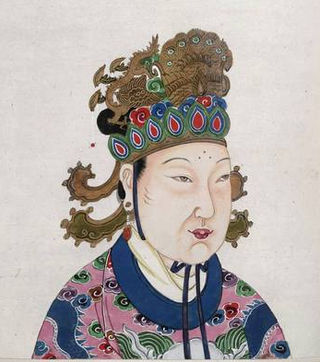
Wu Zetian, personal name Wu Zhao, was Empress of China from 660 to 705, ruling first through others and then in her own right. She ruled first as empress consort, through her husband Emperor Gaozong and then as an empress dowager, through her sons Emperors Zhongzong and Ruizong, from 660 to 690, not unprecedented in Chinese history. She subsequently founded and ruled as female emperor of the Wu Zhou dynasty of China from 690 to 705. She was the only female sovereign in the history of China widely regarded as legitimate. Under her 45-year reign, China grew larger, becoming one of the great powers of the world, its culture and economy were revitalized, and corruption in the court was reduced. She was eventually removed from power during a coup and died a few months later.

Emperor Xuanzong of Tang, personal name Li Longji, was an emperor of the Tang dynasty of China, reigning from 712 to 756 CE. His reign of 44 years was the longest during the Tang dynasty. Through two palace coups, he seized the throne and inherited an empire still in its golden age. He was initially assisted by capable chancellors like Yao Chong, Song Jing and Zhang Yue who were already serving as government officials before Xuanzong ascended the throne. However, under Emperor Xuanzong, the empire reached its turning point and went into sharp decline and near collapse, due to numerous political missteps throughout his long reign, such as over-trusting Li Linfu, Yang Guozhong and An Lushan, with Tang's golden age ending in the An Lushan Rebellion.

Emperor Gaozong of Tang, personal name Li Zhi, was the third emperor of the Chinese Tang dynasty, ruling from 649 to 683; after January 665, he handed power over the empire to his second wife Empress Wu, and her decrees were carried out with greater force than the decrees of Emperor Gaozong's. Emperor Gaozong was the youngest son of Emperor Taizong and Empress Zhangsun; his elder brothers were Li Chengqian and Li Tai.
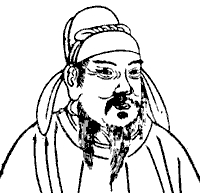
Emperor Zhongzong of Tang, personal name Li Xian, and at other times Li Zhe or Wu Xian, was the fourth and seventh emperor of the Tang dynasty of China, ruling briefly in 684 and again from 705 to 710. During the first period, he did not have actual power, which was in the hands of his mother, Empress Wu Zetian and he was overthrown on her orders after opposing his mother. During his second reign, most of the power was in the hands of his consort Empress Wei.
Princess Taiping (Chinese: 太平公主; pinyin: Tàipíng Gōngzhǔ, lit. "Princess of Great Peace", personal name unknown, possibly Li Lingyue was a royal princess and prominent political figure of the Tang dynasty and her mother Wu Zetian's Zhou dynasty. She was the youngest daughter of Wu Zetian and Emperor Gaozong and was influential during the reigns of her mother and her elder brothers Emperor Zhongzong and Emperor Ruizong, particularly during Emperor Ruizong's second reign, when for three years until her death, she was the real power behind the throne.

Emperor Daizong of Tang, personal name Li Yu, né Li Chu, was an emperor of the Chinese Tang dynasty.
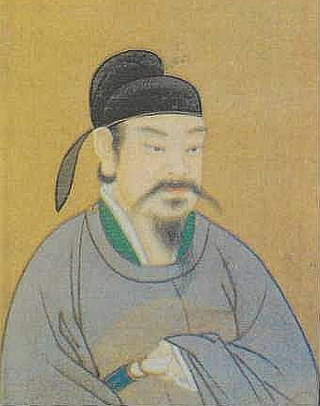
Emperor Ruizong of Tang, personal name Li Dan, also known at times during his life as Li Xulun, Li Lun, Wu Lun, and Wu Dan, was the fifth and ninth emperor of the Chinese Tang dynasty. He was the eighth son of Emperor Gaozong and the fourth son of Emperor Gaozong's second wife Empress Wu. He was wholly a figurehead during his first reign when he was controlled by his mother, and he was the titular and puppet ruler of the Tang Empire from 684 to 690. During his second reign after his mother's death, significant power and influence was exercised by his sister Princess Taiping.
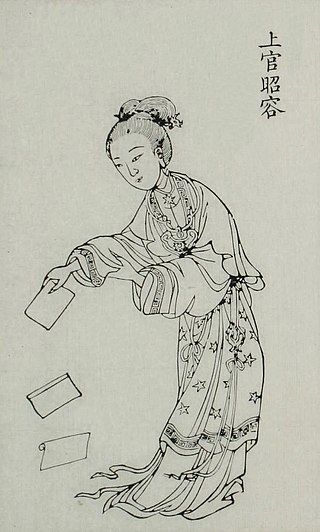
Shangguan Wan'er was a Chinese politician, poet, and imperial consort of the Wu Zhou and Tang dynasties. Described as a "female prime minister," Shangguan rose from modest origins as a palace servant to become secretary and leading advisor to Empress Wu Zetian of Zhou. Under Empress Wu, Shangguan exercised responsibility for drafting imperial edicts and earned approbation for her writing style. She retained her influence as consort to Wu's son and successor, Emperor Zhongzong of Tang, holding the imperial consort rank of Zhaorong (昭容). Shangguan was also highly esteemed for her talent as a poet. In 710, after Emperor Zhongzong's death, Shangguan was killed during a palace coup that ended the regency of Empress Dowager Wei.

Li Xian, courtesy name Mingyun, formally Crown Prince Zhanghuai, named Li De from 675 to 680, was a crown prince of the Chinese Tang dynasty. He was the sixth son of Emperor Gaozong, and the second son of his second wife Empress Wu. He was known for writing commentaries for the Book of Later Han, the official history of the Eastern Han dynasty. He became crown prince in 675 after his older brother Li Hong's death, but soon fell out of favor and generosity with Empress Wu herself and that's what caused his downfall. In 680, Empress Wu had her associates accuse Li Xian of treason, and he was demoted to commoner rank and exiled. In 684, after Emperor Gaozong's death, Empress Wu, then empress dowager, had her associate Qiu Shenji (丘神勣) visit Li Xian to force him to commit suicide.
Li Ke, posthumously known as the Prince of Yùlín (鬱林王), often known by his greater title as the Prince of Wú (吳王), was an imperial prince of the Tang dynasty. As a highly honored son of Emperor Taizong, he was one time considered a possible candidate as crown prince after both his older brother Li Chengqian and younger brother Li Tai were both deposed in 643, but eventually, his younger brother Li Zhi, as a son of Emperor Taizong's wife Empress Zhangsun, was created crown prince and inherited the throne after Emperor Taizong's death in 649, under the insistence of Li Zhi's uncle and Emperor Taizong's brother-in-law Zhangsun Wuji. Zhangsun, however, detested Li Ke, and in 653, he implicated Li Ke in a plot by the official Fang Yi'ai (房遺愛) and had Emperor Gaozong order Li Ke to commit suicide.
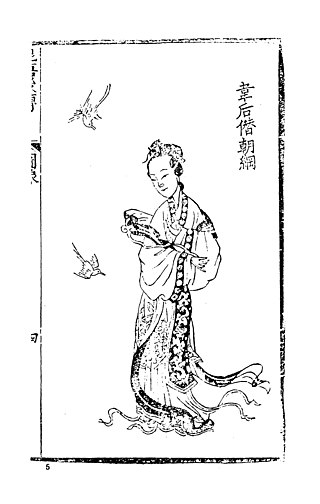
Empress Wei was an empress consort of the Chinese Tang dynasty. She was the second wife of Emperor Zhongzong, who reigned twice, and during his second reign, she tried to emulate the example of her mother-in-law Wu Zetian and seize power. She was de facto in charge of the governmental affairs during her husband's reign, though she was not formally regent. Emperor Zhongzong's death in 710 — a death traditionally believed to be a poisoning she carried out together with her daughter Li Guo'er the Princess Anle — made her the empress dowager, and she took formal power as regent de jure during the minority of Emperor Shang of Tang. After a reign of seventeen days as regent, she was overthrown and killed in a coup led by Emperor Zhongzong's nephew Li Longji and Emperor Zhongzong's sister Princess Taiping.
Li Chongjun (李重俊), formally Crown Prince Jiemin (節愍太子), was a crown prince of the Chinese Tang dynasty, during the second reign of his father Emperor Zhongzong. He was made crown prince because the only son of his father's wife Empress Wei, Li Chongrun, had been killed before his father's return to the throne, but on account of his mother's low birth, he was often humiliated by Empress Wei's daughter Li Guo'er the Princess Anle and her husband Wu Chongxun (武崇訓). In 707, in anger, he started a coup and killed Wu Chongxun and his father Wu Sansi the Prince of Dejing, but his subsequent attempt to arrest Empress Wei, Li Guo'er, and Consort Shangguan Wan'er was thwarted, and he was killed in flight.
Princess Anle, personal name Li Guo'er (李裹兒), was a Chinese princess of the Tang dynasty. She was the youngest daughter of Emperor Zhongzong and his wife Empress Wei. Popular history holds that she was doted upon heavily by her parents and siblings, which contributed to her later drive for power.
Li Chengqi, known as Wu Chengqi during the reign of his grandmother Wu Zetian and as Li Xian after 716, formally Emperor Rang, was an imperial prince of the Tang dynasty who served as crown prince during the first reign of his father Emperor Ruizong, who yielded that position to his younger brother Li Longji during Emperor Ruizong's second reign. Li Chengqi had a number of children, including his oldest son, Li Jin, the Prince of Ruyang, who was called one of the Eight Immortals of the Wine Cup by famous poet Du Fu.
Wu Youji, posthumous name Prince Zhongjian of Ding (定忠簡王), was an imperial prince of the Wu Zhou dynasty and an official of the Tang dynasty. He is best known as the second husband of Wu Zetian's powerful daughter Princess Taiping.
Wu Sansi, known posthumously as Prince Xuan of Liang (梁宣王), was a Chinese prince and politician of the Tang and Wu Zhou dynasties. Wu Sansi served as a chancellor and imperial prince during the reign of his aunt, Empress Wu Zetian of Zhou, and was again a powerful chancellor during the second reign of Empress Wu's son, Emperor Zhongzong of Tang. He was aided in navigating the fraught period that followed Emperor Zhongzong's restoration by successive affairs with the influential consort Shangguan Wan'er and the powerful Empress Wei. Although he amassed significant authority and enjoyed the trust of Emperor Zhongzong, he was killed during an unsuccessful rebellion by the crown prince Li Chongjun in 707.
Li Duozuo, formally the Prince of Liaoyang (遼陽王), was an ethnically Mohe general of the Chinese Tang dynasty and Wu Zetian's Zhou dynasty. He is mostly known for his participation in the successful coup of 705 that overthrew Wu Zetian and returned her son Emperor Zhongzong to the throne, and the failed coup of 707 in which Emperor Zhongzong's son Li Chongjun tried to overthrow Emperor Zhongzong's wife Empress Wei.
Li Ying (李瑛), né Li Siqian (李嗣謙), known from 725 to 736 as Li Hong (李鴻), was a crown prince of the Chinese Tang dynasty during the reign of his father Emperor Xuanzong. He was later removed and forced to commit suicide due to the machinations of Emperor Xuanzong's favorite and influential concubine Consort Wu and her powerful and corrupt ally, the chancellor Li Linfu.
Consort Wu, imperial consort rank Huifei (武惠妃), posthumously Empress Zhenshun, was an imperial consort of the Chinese Tang dynasty, during the reign of Emperor Xuanzong. She was Emperor Xuanzong's favorite concubine during her lifetime, and after the death of his wife Empress Wang in 724, she became honored like an empress inside the palace, court, by the emperor and among the public until her death; Thus, she was the undisputed mistress of the palace, and wielded political power in the court and influence over the decisions of Emperor Xuanzong. She never formally became empress on account of her father Wu Youzhi (武攸止) being a nephew of Emperor Xuanzong's grandmother Wu Zetian, the memory about whose takeover of the Tang throne terrified the officials. But the power she gained within the palace and the political circles of the court, and the love of Emperor Xuanzong for her, made her authority and respect equal to the authority and respect of the empress.
Wu Shun (武顺) (623-665) was the Lady of Han during the Tang dynasty and the older sister of Wu Zetian. The Lady of Han was an honorable title for relatives of the Emperor and Empress. Wu Shun was allegedly the mother of Li Xian, the crown prince, and the rumors eventually led to his demise. In all likelihood, her sister Empress Wu, who had become a full-fledged power behind the throne after January 665, ordered her poisoning.